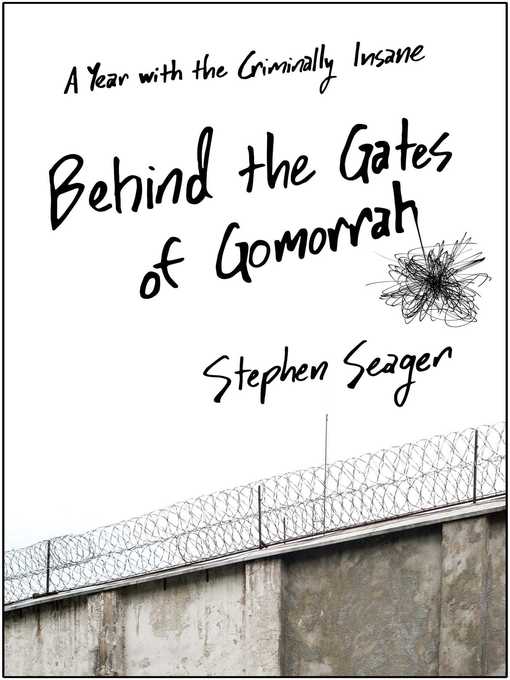
Behind the Gates of Gomorrah
A Year with the Criminally Insane
کتاب های مرتبط
- اطلاعات
- نقد و بررسی
- دیدگاه کاربران
نقد و بررسی

July 28, 2014
When psychiatrist Seager (Street Crazy : America’s Mental Health Tragedy) accepted a job at Gordon State Hospital, he was no stranger to chaos—he’d already worked as an ER doctor for 11 years—but nothing could prepare him for the levels of violence and discord he’d soon encounter at this California facility dedicated to serving a motley crew of psychopaths, sexual predators, vicious convicts, and the mentally ill. In this riveting account, he chronicles his year on the job, which begins with a horrific assault on his first day, slowly uncovering a twisted ecosystem in which inmates extort money from staff and patients alike, in which a vicious convict will attempt to kill a fellow patient one day, only to administer CPR to save the life of another, and Santa bellows obscenities and is dragged kicking and screaming from a Christmas party. This day-to-day tedium coupled with the ever-present threat of violence adds tension to Seager’s story, but when the author attempts to tie in a critique of the state and local government’s approach to dealing with mental illness, the narrative falls flat. Seager’s attempt to tell so many stories—his own, his patients, and the system’s—only dilutes his tale.

August 15, 2014
Board-certified psychiatrist Seager (Street Crazy: America's Mental Health Tragedy, 2000, etc.) recounts his 12 harrowing months at Northern California's Napa State Hospital. As a newcomer to the psychiatric facility, the author was immediately immersed in the drastic severity of the psychotic patients housed in "Unit C," a compound with security rivaling that of San Quentin prison. After being assaulted within minutes, Seager began reconsidering his job decision, especially after learning that the unit's previous psychiatrist was put in a coma after being attacked. Dubbed "Gomorrah," the hospital ward soon lived up to its moniker as a house of violence not readily obvious from its manicured grounds. The author chronicles months of daily, terrifying patient interactions, which tested not only his personal fortitude, but his professionalism as a mental health caregiver. Though all had murder on their rap sheets, the scariest of Unit C's 40 residents was hulking, unpredictable Bill McCoy, whom everyone feared most yet wouldn't be policed for his in-house extortion due to the circuitous nature of the prison system (he'd only end up back at Napa State). Some patients wore paper Zorro masks and smeared feces on themselves, while others hid makeshift distillery contraptions in their closets or sold fermented fruit cocktail as prison alcohol; the remainder were a manageably maniacal lot with short tempers. Special events like Halloween proved bizarre; Thanksgiving dinners were somber, with minimal visitors (many residents had killed their own families). Though relentlessly unsettling and grim, there are spots of levity. Seager's descriptions can be darkly humorous: On a particularly bad day, the author became "engulfed in a wave of hungry psychopaths eagerly churning their way to the cafeteria." In the final chapter, the author urges citizens to become proactive in enacting legislation to change how state hospitals are run, thus increasing their safety quotients and those of the communities they serve. A chilling account of a livelihood spent curating the criminally psychotic.
COPYRIGHT(2014) Kirkus Reviews, ALL RIGHTS RESERVED.

September 15, 2014
The dilemma of treating those who commit public shootings and other violent crimes is explored here through the work of a psychiatrist in Gorman ("Gomorrah") State, a California forensic mental hospital. Seager (former assistant professor of psychiatry, Univ. of California Los Angeles Sch. of Medicine; Street Crazy) presents harrowing details about daily life in such a facility. He succinctly reviews the history of mental illness treatment in the United States and the evolution of these hospitals in the context of the movement toward increasing patient rights. This is also a fast-moving and engaging work with vivid descriptions of the underground economy in such a closed institution and the colorful though dangerous individuals who inhabit it. The chapters are episodic based on the course of the author's career at the facility. In conclusion, Seager discusses the policy implications of this case study, calling for a more targeted and intense treatment focus on identifiable potential perpetrators of heinous violent crimes. Offering a rare insider's view of life in a locked criminal psychiatric ward, this book is well suited to general readers. VERDICT A riveting blend of memoir and mental-health policy commentary that should appeal to fans of reality-based sagas of the criminally insane and those who care for them.--Antoinette Brinkman, formerly with Southwest Indiana Mental Health Ctr. Lib., Evansville
Copyright 2014 Library Journal, LLC Used with permission.

September 1, 2014
Feeling the financial crunch of 2008, Seager gladly accepts work as a doctor-psychiatrist at California's Napa State Hospital (aka Gomorrah) for the criminally insane, but he is quickly moved to Ward C, where the worst of the worst are kept and, classified as mental patients in addition to being criminals, allowed to mingle with the staff and each other. Seager never quite swallows his fear, and the book details why. The doctor he replaced died from an attack by a patient, and such assaults on staff and on other patients are nearly daily occurrences. Seager works in some of the facts detailing how such institutions as Gomorrah came to be and the flaws inherent in such a system. Ward C's men are both violent and mentally ill (or pretend to be mentally ill ), and they are dangerous. Lighthearted moments occura baseball game between the Nuts and the Quacksbut this book is a chiller in nearly every way, and Seager, despite his ongoing misgivings, doesn't quit, even when one patient, one of the relatively good guys, states, Somebody should blow this place up. (Reprinted with permission of Booklist, copyright 2014, American Library Association.)

























دیدگاه کاربران